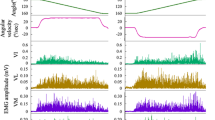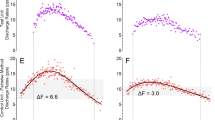Abstract
Gastrocnemii muscle fibers shorten when the knee joint is in a flexed compared to an extended position. This leads to inhibition of medial gastrocnemius (MG) motor units, however, it is unclear whether this affects motor unit properties of the lateral gastrocnemius (LG) or soleus (SOL). We recorded 171 motor units from the MG (61), LG (39) and SOL (71) at an extended (160°) and flexed (100°) knee joint position with the ankle and hip joints at 90°. Subjects performed isometric ramp plantar flexion contractions at 25, 50 and 100% of the maximal voluntary contraction. MG (p = 0.0002) and LG (p = 0.02) motor unit recruitment thresholds (RT) were higher, whereas only MG motor unit firing rates (FR) were lower (p = 0.008) in the flexed compared to the extended knee joint position. SOL motor unit RT (p = 0.66) and FR (p = 0.08) were not statistically different between positions. When comparing properties of the same motor unit followed during contractions at both knee joint positions, RT of ten gastrocnemii motor units were higher (p = 0.0008) and FR were lower (p = 0.01) when the knee was flexed. Additionally, in six SOL motor units, RT (p = 0.42) and FR (p = 0.96) were not different between the two positions. Thus, MG and LG activation is similarly inhibited during plantar flexion contractions in a flexed compared to an extended knee joint position. Furthermore, our findings indicate that knee joint position changes have no effect on SOL excitability.



Similar content being viewed by others
References
Altenburg TM, de Haan A, Verdijk PW, van Mechelen W, de Ruiter CJ (2009) Vastus lateralis single motor unit EMG at the same absolute torque production at different knee angles. J Appl Physiol 107:80–89
Antonios T, Adds PJ (2008) The medial and lateral bellies of gastrocnemius: a cadaveric and ultrasound investigation. Clin Anat 21(1):66–74
Bates DM, Maechler M, Bolker B (2012) lme4: Linear mixed-effects models using S4 classes. R package version 0.999999-0
Bigland-Ritchie BR, Furbush FH, Gandevia SC, Thomas CK (1992) Voluntary discharge frequencies of human motoneurons at different muscle lengths. Muscle Nerve 15(2):130–137
Butler TJ, Kilbreath SL, Gorman RB, Gandevia SC (2005) Selective recruitment of single motor units in human flexor digitorum superficialis muscle during flexion of individual fingers. J Physiol 567:301–309
Cheng J, Brooke JD, Staines WR, Misiaszek JE, Hoare J (1995) Long-lasting conditioning of the human soleus H reflex following quadriceps tendon tap. Brain Res 681:197–200
Christova P, Kossev A, Radicheva N (1998) Discharge rate of selected motor units in human biceps brachii at different muscle lengths. J Electromyogr Kinesiol 8:287–294
Cresswell A, Löscher W, Thorstensson A (1995) Influence of gastrocnemius muscle length on triceps surae torque development and electromyographic activity in man. Exp Brain Res 105:283–290
Dalton BH, Power GA, Allen MD, Vandervoort AA, Rice CL (2012) The genu effect on plantar flexor power. Eur J Appl Physiol 113(6):1431–1439
De Luca CJ (1997) The use of surface electromyography in biomechanics. J Appl Biomech 13(2):135–163
Farina D, Merletti R, Enoka RM (2014) The extraction of neural strategies from the surface EMG: an update. J Appl Physiol 117(11):1215–1230
Hébert-Losier K, Schneiders AG, García JA, Sullivan SJ, Simoneau GG (2011) Peak triceps surae muscle activity is not specific to knee flexion angles during MVIC. J Electromyogr Kinesiol 21(5):819–826
Henneman E (1957) Relation between size of neurons and their susceptibility to discharge. Science 126:1345–1347
Henneman E, Somjen G, Carpenter DO (1965) Functional significance of cell size in spinal motoneurons. J Neurophysiol 28:560–580
Héroux ME, Dakin CJ, Luu BL, Inglis JT, Blouin JS (2014) Absence of lateral gastrocnemius activity and differential motor unit behavior in soleus and medial gastrocnemius during standing balance. J Appl Physiol 116:140–148
Herzog W, Leonard TR, Guimaraes AC (1993) Forces in gastrocnemius, soleus, and plantaris tendons of the freely moving cat. J Biomech 26:945–953
Johnson MA, Polgar J, Weightman D, Appleton D (1973) Data on the distribution of fibre types in thirty-six human muscles An autopsy study. J Neurol Sci 18:111–129
Kamo M (2002) Discharge behavior of motor units in knee extensors during the initial stage of constant-force isometric contraction at low force level. Eur J Appl Physiol 86:375–381
Kawakami Y, Ichinose Y, Fukunaga T (1998) Architectural and functional features of human triceps surae muscles during contraction. J Appl Physiol 85:398–404
Kennedy P, Cresswell A (2001) The effect of muscle length on motor-unit recruitment during isometric plantar flexion in humans. Exp Brain Res 137(1):58–64
Kennedy PM, Cresswell AG, Chua R, Inglis JT (2004) Galvanic vestibular stimulation alters the onset of motor unit discharge. Muscle Nerve 30(2):188–194
Kirk EA, Rice CL (2017) Contractile function and motor unit firing rates of the human hamstrings. J Neurophysiol 117(1):243–250
Lauber B, Lichtwark GA, Cresswell AG (2014) Reciprocal activation of gastrocnemius and soleus motor units is associated with fascicle length change during knee flexion. Physiol Rep 2(6):e12044
Miaki H, Someya F, Tachino K (1999) A comparison of electrical activity in the triceps surae at maximum isometric contraction with the knee and ankle at various angles. Eur J Appl Physiol 80(3):185–191
Misiaszek JE, Brooke JD, Lafferty KB, Cheng J, Staines WR (1995) Long-lasting inhibition of the human soleus H reflex pathway after passive movement. Brain Res 677:69–81
Misiaszek JE, Cheng J, Brooke JD, Staines WR (1998) Movement induced modulation of soleus H reflexes with altered length of biarticular muscles. Brain Res 795:25–36
Murray MP, Guten GN, Baldwin JM, Gardner GM (1976) A comparison of plantar flexion torque with and without the triceps surae. Acta Orthop Scand 47:122–124
Pinniger GJ, Nordlund MM, Steele JR, Cresswell AG (2001) H-reflex modulation during passive lengthening and shortening of the human triceps surae. J Physiol 534(3):913–923
Tamaki H, Kitada K, Akamine T, Sakou T, Kurata H (1996) Electromyogram patterns during plantarflexions at various angular velocities and knee angles in human triceps surae muscles. Eur J Appl Physiol 75(1):1–6
Tanabe S, Muraoka Y, Kamiya A, Tomita Y, Masakado Y (2005) Soleus H-reflex modulation pattern for a fine angle of hip and knee joint passive movement. Int J Neurosci 115(1):1–11
Tokuno CD, Lichtwark GA, Cresswell AG (2012) Modulation of the soleus H-reflex during knee rotations is not consistent with muscle fascicle length changes. Eur J Appl Physiol 112(9):3259–3266
Zajac FE, Faden JS (1985) Relationship among recruitment order, axonal conduction velocity, and muscle-unit properties of type-identified motor units in cat plantaris muscle. J Neurophysiol 53:1303–1322
Funding
This research was supported by the Natural Sciences and Engineering Research Council of Canada (NSERC).
Author information
Authors and Affiliations
Corresponding author
Ethics declarations
Conflict of interest
The authors declare that they have no conflict of interest.
Additional information
Publisher's Note
Springer Nature remains neutral with regard to jurisdictional claims in published maps and institutional affiliations.
Rights and permissions
About this article
Cite this article
Hali, K., Kirk, E.A. & Rice, C.L. Effect of knee joint position on triceps surae motor unit recruitment and firing rates. Exp Brain Res 237, 2345–2352 (2019). https://doi.org/10.1007/s00221-019-05570-7
Received:
Accepted:
Published:
Issue Date:
DOI: https://doi.org/10.1007/s00221-019-05570-7




